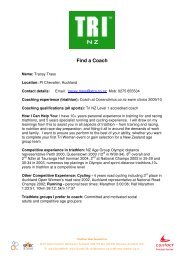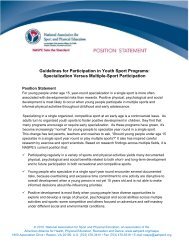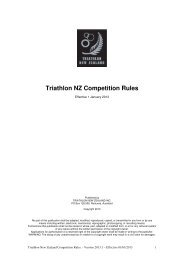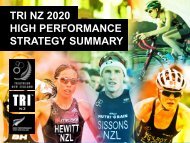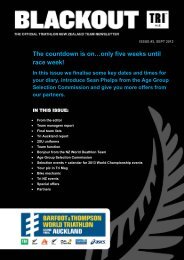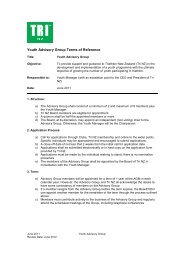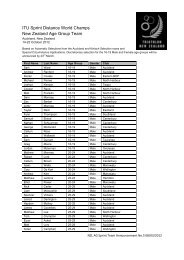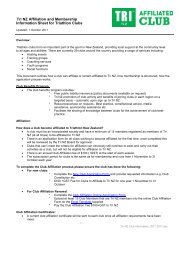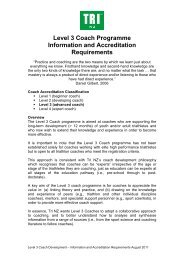Cycling Your Periodization - United States Olympic Committee
Cycling Your Periodization - United States Olympic Committee
Cycling Your Periodization - United States Olympic Committee
Create successful ePaper yourself
Turn your PDF publications into a flip-book with our unique Google optimized e-Paper software.
U S O CThe preparatory period should be relatively longer forinexperienced athletes in order to allow for sufficient developmentof basic fitness. However, in elite athletes the preparatory periodmay be relatively short due to frequent competitions and thenecessity of elite athletes to remain close to top conditionthroughout the training year (Francis and Patterson 1992; Siff1996b; Siff and Verkhoshansky 1993; Zatsiorsky 1995).An athlete requires approximately 22 to 25 weeks to reach peakperformance (Verkhoshansky 1985) before a type of fatigue orexhaustion occurs that is poorly understood (Poliquin 1991).Experience has shown that performance generally declines withinthese times constraints, but the mechanisms of the decline areunknown.This idea of a limited time for adaptation leads to the conceptof multiple periodization, which simply means that the trainingyear is usually divided into two, rarely more, phases consisting ofpreparatory, competitive and transition periods (Bompa 1990a,1990b, 1993; Siff and Verkhoshansky 1993; Verkhoshansky1985). Perhaps unfortunately, many modern training programsforce athletes to attempt to peak too often.Description of the PeriodsThe preparatory period is usually divided into general andspecific phases. The general preparatory phase is used for broador multilateral training (Bompa, 1990b). The training tasksare aimed at improving the athlete’s overall strength, flexibility,stamina, coordination, and so forth.The specific preparatory phase more closely resembles the sportand sport-specific tasks. Training during the specific preparatoryphase are aimed at improving sport-specific tasks and fitness suchas jumping, flexibility and strength in extreme ranges of motionand applying any newly acquired fitness to solving specific sporttasks.The competitive period involves the majority of competitionsduring the particular season or macrocycle. The fitness ofthe athlete should be relatively stable during this period, andtraining focuses on maximizing and stabilizing performance.The preparatory period is linked to the competitive period inthat a well-executed preparatory period, with sufficient durationto achieve a high level of fitness at a reasonable pace, allowsthe athlete to demonstrate more stable performances duringthe competitive period (Harre 1982; Siff and Verkhoshansky1993;Verkhoshansky 1985). The idea of performance stabilityis particularly important for athletes in resistance training, andmay differ somewhat from sport to sport. For example, thetactical approach of a pole vaulter is quite different from that ofa diver. The pole vaulter may often face performances that he orshe has never equaled. This is seen in personal-best records. Thepole vaulter may try previously unachieved heights in manycompetitions throughout a season. The diver should face thistype of scenario only in the protected environment of training.The diver must perform what he or she has performed (i.e. dives)hundreds or thousands of times before, but must perform divesprecisely in the decisive moment of competition. No byes orfailed attempts are allowed in diving. Therefore, the diver seeksto stabilize performance at a level that is consistent with his or herskills, while the pole vaulter must assault and achieve new levelsof performance during a competition and can use more than oneattempt.The transition or rest period involves one to four, rarely more,weeks of reduced training load to facilitate recovery from the rigorsof previous training both physically and mentally (Bompa 1990a,1990b; Harre 1982, 1986; Siff and Verkhoshansky 1993). Duringthe transition period the athlete should attempt to maintain fitnesswhile allowing injuries to heal, develop new goals for the nextcompetitive season, evaluate the previous competitive season andbasically ensure that the next competitive season begins with arenewed vigor and commitment.Types of PeriodsThere are a number of different types of periods of trainingdepending on training goals, time of the season and capabilities ofthe athlete. Macrocycles are usually described based on commonsense understanding of the nature of the competitions within themacrocycle. For example, there may be an <strong>Olympic</strong> preparationtype of macrocycle due to the modification of competitionschedules to fit properly with the <strong>Olympic</strong> Games. There mayalso be a Pan American, national championship, or other typesof macrocycles depending on the most important goal of themacrocycle. The second level, mesocycles can be categorized byO L Y M P I C C O A C H 1 3 V O L U M E 2 0 N U M B E R 1



